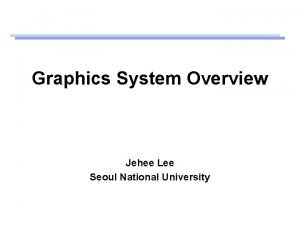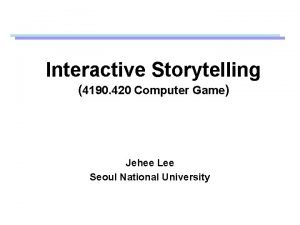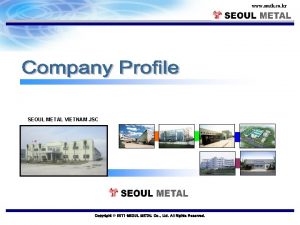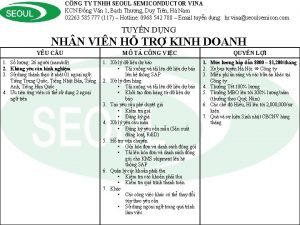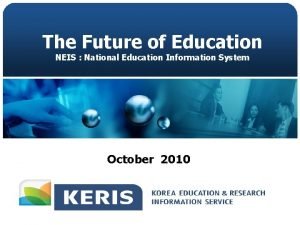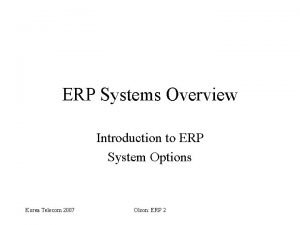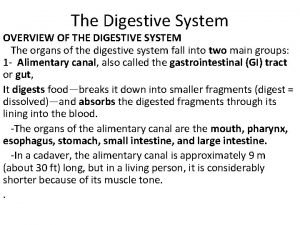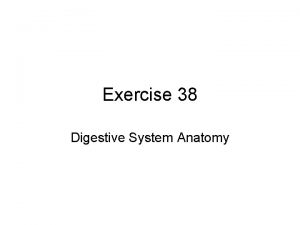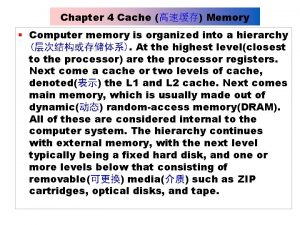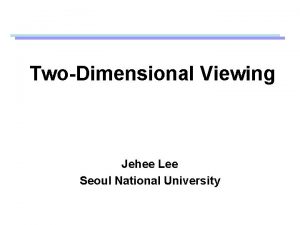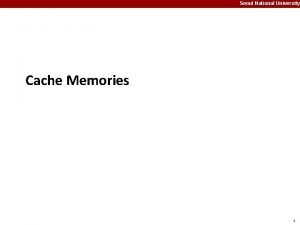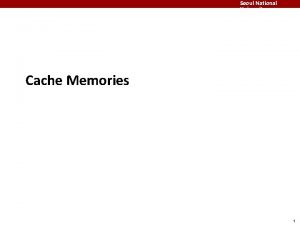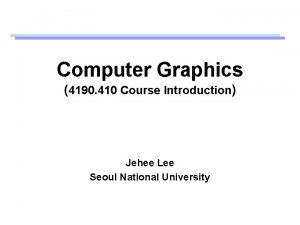Graphics System Overview Jehee Lee Seoul National University
































- Slides: 32

Graphics System Overview Jehee Lee Seoul National University

Video Display Devices • Cathode Ray Tube(CRT) is the most common display device – – High resolution Good color fidelity High contrast (400: 1) High update rates

Vector vs Raster CRT • Vector displays: a list of line endpoints was used to move the electron beam along some random path, a socalled vector scan. • Raster displays (TVs etc) drive the beam in a regular pattern called a raster scan. • Vector displays are almost extinct. • Scan conversion: convert geometric primitives from vector scan descriptions (endpoints etc. ) to raster scan descriptions (sets of pixels to turn on. )

Frame Buffers • The 2 -D array of pixel values is called a frame buffer – Frame, refresh, raster buffers are used interchangeably • Each row of pixels is called a scan-line or a raster line • Frame buffer can be peripheral to the host or resident as part of the host computer's address space. • The video hardware continuously scans the frame buffer. • Types of display – B&W displays: 1 bit/pixel (bitmap). – Basic color displays: 8, 15, 16, or 24 bits. – High-end displays: 96 or more bits.

Full-Color (RGB) Displays • For 24 bit color: – store 8 bits each of red, green, and blue per pixel. – E. g. (255, 0, 0) is pure red, and (255, 255) is white. – 2^24 = 16 million colors. • For 15 bit color: 5 bits red + 5 green + 5 blue • The video hardware uses the values to drive the R, G, and B guns.

Color Lookup Table • A single number (e. g. 8 bits) stored at each pixel. – Used as an index into an array of RGB triples. – With 8 bits per pixel, you can get the 256 colors of your choice

Deeper Frame Buffers • Some frame buffers have 96 or more bits per pixel. What are they all for? We start with 24 bits for RGB. • Alpha channel: an extra 8 bits per pixel, to represent “transparency. ” Used for digital compositing. That’s 32 bits. • A Z-buffer, used to hold a “depth” value for each pixel. Used for hidden surface 3 -D drawing. 16 bits/pixel of “z” brings the total to 48 bits. • Double buffering: – – – For clean-looking flicker-free real time animation. Two full frame buffers (including alpha and z). Only one at a time is visible—you can toggle instantly. Draw into the “back buffer” (invisible), then swap. Can be faked with off-screen bitmaps (slower. ) 2 x 48 = 96.

Display Resolution X Windows term Meaning Pseudo. Color colormapped with color display (8 or 4 bit) High Color RGB (15=5+5+5 or 16=5+6+5 bit) True Color, Direct Color RGB (24=8+8+8 bit) • Spatial resolution: The maximum number of points that can be displayed without overlap on a CRT. • Higher resolution gives a shaper image • Intensity or color resolution depends on – frame buffer resolution – display H/W characteristics – sampling method

Raster CRT Display • Dynamic display which means that the display needs to be refreshed in order to keep a pattern being displayed. • Refreshing should be the responsibility of the device: – buffer memory (frame buffer) – a dedicated processor, called video controller, constantly copies color intensity values from the frame buffer onto screen, scanline by scanline. Such a process is called refresh. – Refresh rate = # of refreshes per second

Display Processor • Raster graphics system with a dedicated display processor

Interlacing • Lower refresh rates result in flickering, which is the visually discernible disruption of light intensity on screen. • An acceptable refresh rate is determined by the acuity of the human vision. • Refresh rate must be matched with the excitement persistence of phosphor coating. • Interlacing – a usual frame display rate : 60 Hz – divide a frame into even-numbered scan lines and odd -numbered scan-lines(each 1/60 sec) ⇒ whole frame takes 1/60 + 1/60 = 1/30 sec • Recently, progressive scan is becoming popular

Flat Panel Displays • Plasma-panel (gas-discharging) displays • Liquid crystal displays • Comparison to CRT – Thin, light – Flicker free – Narrower color gamut

Output Devices • Stereoscopic viewing glasses: the user wears them to perceive stereoscopic view of 3 D scenes displayed on screen – Used in screen-based Virtual Reality (VR) – Has high resolution – Limited head-movement • Head-mounted display (HMD): two small TV screens are embedded in a rack and placed in front of the two eyes. – It allows full-freedom head movement, and gives the feel of immersion – Widely used in Virtual Reality (VR) – A tracking system is used to report the position of HMD in 3 D space. • Plotter • Printer

Output Devices • Wide Screen

Input Devices • Keyboard • Mouse • Trackball: a 2 D input device, usually used on a mouse or a lap-top computer. • Space ball: hand held, non-movable. It uses a strain gauge to detect pull, push, and twist applied to the ball, and translate them into 3 D locations. Used for navigation in virtual environments, CAD, etc. • Head Mounted Display: Although it is primarily a display device, it can also track position and orientation • Joystick: similar to the space ball. Can be movable and non-movable.

Input Devices • Data glove: a glove with sensors. Used to control a virtual hand for grasping, dropping, and moving an object in a virtual environment. • Image scanner: input still picture, photo, or slides as images into computer. • Touch panel: highly transparent and embedded over a display surface. • Digital camera: directly stores photo shots as images on a diskette. • Digital video recorder: input a video clip in digital form; often used for teleconferencing. • Laser range scanner: input discrete and scattered points on a 3 D surface model from which a digital one can be built.

Input Devices • Motion Capture: input full-body, facial, hand movements

Motion Capture • Reptile capture • Breakdance • Dynamic duo

Graphics Rendering Pipeline • Rendering: the conversion of a scene into an image 3 D Scene render 2 D Image – Scene is composed of “models” in 3 D space. – Models are composed of “primitives” supported by graphics packages such as Open. GL. – Models entered by hand or created by a program

Graphics Rendering Pipeline • • Modeling (local) coordiantes World coordinates Normalized (device-independent) coordinates Device (screen) coordinate

Functions of a Graphic Package Graphics Library such as Core, Open. GL, Direct. X • • • Provide primitives for graphic description Build and maintain graphic representation models Provide primitives for viewing operations Support user interaction with application program Interact directly with users to allow them modify viewing parameters, if possible

Graphics System API CGI (Computer Graphics Interface) Graphics system: a library of graphics functions

General Graphics Packages • Graphics packages are device-independent • Official Standards – – – Core: ACM SIGGRAPH 1977, U. S. GKS : ANSI 85, 2 D, Europe GKS-3 D : ANSI 88 PHIGS : ANSI 88 - Hierarchical structures PHIGS+ : ISO 92 • Non-official Standards – – – X Window System, PEX Silicon Graphics Open. GL (1992) Open Inventor Microsoft Direct. X Sun Mircorsystems VRML

Bit-Mapped vs. Object-Based • Painting programs – bit-mapped representation – e. g. , Adobe Photoshop, bit-map fonts • Drawing programs – object-based representation – e. g. , Powerpoint, outline fonts

Bit-Mapped Graphics • Bit-mapped memory - represent graphical images and patterns by assigning a block of memory for the direct storage of the intensity patterns • Objectiveness of a line, polygon, or brush stroke is lost • Limitations – pixel democracy - all pixels are created equal once, they are set in a bit-mapped image – no support of images requiring precision or numerical dimensioning device dependency

Object-Based Graphics • Mathematical representation of lines, rectangles, ovals, polynomial curves, and so on. • Objectiveness is maintained – Objects designed may have a hierarchical structure – Easily editable • Difficulties – the representation is more complex

Image File Formats • GIF (Graphics Interchange Format) – the Compu. Serve Information Service and F&R Block Company – copyrighted bitmap format – uses compression – can store only 256 -color images, any size

Image File Formats • TIFF (Tag-based Image File Format) – Aldus Corp. and Microsoft to support digital scanner manufacturers and desktop publishing systems to describe and store raster image data – run-length encoding with compression. – independent of OS, processors, compilers, and filing systems – become a standard for image storage and communication

Image File Formats • JPEG – international compression standard (1992) – high compression rate can be acquired by removing the following redundancy in an image: • spatial (between neighboring pixels), • spectral (between color planes), • temporal (between adjacent frames in a sequence) – highly lossy compression But, objectionable blocking artifacts may occur. – poor lossless compression efficiency (less than 3) – lossy compression method is limited to input images with maximum bit depth of 8 bits/pixel. – lossless support 2 to 16 bits/pixel. – no support for true-color

Image File Formats • JPEG 2000 – new international compression standard (2002. 1) – significantly higher compression efficiency than JPEG – new functionalities: • integrated lossy/lossless compression • region-of-interest(ROI) encoding • Multi-resolution capability • progressive decoding

Image File Formats • EPS (Encapsulated Post. Script) – – – Adobe Systems Incorporated importing and exporting Post. Script language files grayscale or color usually ASCII No compression can be mix of raster and geometric data

Image File Formats Comparison BITS PER PIXEL FILE SIZE JPEG 24 TIFF 8, 24 medium good GIF 1, 4, 8 medium no good for colorful images EPSF 1, 2, 4, 8, 24 small COMMENTS huge lossy, good for archives good for printing
 Basiccolor input
Basiccolor input Secondary action
Secondary action Seoul national university computer science
Seoul national university computer science Seoul national university history
Seoul national university history Seoul national university events
Seoul national university events Jehee
Jehee Undergraduate graduate postgraduate
Undergraduate graduate postgraduate Most of the graphics monitors today operate as
Most of the graphics monitors today operate as Graphics hardware in computer graphics ppt
Graphics hardware in computer graphics ppt Seoul metal vietnam
Seoul metal vietnam The seoul accord agreement accredits
The seoul accord agreement accredits Seoul metro map
Seoul metro map Công ty seoul semiconductor vina
Công ty seoul semiconductor vina Neis korea
Neis korea Seoul semiconductor vina
Seoul semiconductor vina Seoul
Seoul Sunsangnim
Sunsangnim Matei purice
Matei purice Overview on the national tuberculosis elimination program
Overview on the national tuberculosis elimination program Erp 2 systems
Erp 2 systems Introduction to content management system
Introduction to content management system Accounting system overview
Accounting system overview Overview of the digestive system
Overview of the digestive system Crtd in sap
Crtd in sap Operating system overview
Operating system overview Gym management system class diagram
Gym management system class diagram Anatomy of the digestive system exercise 38
Anatomy of the digestive system exercise 38 Set associative mapping in cache memory
Set associative mapping in cache memory Computer memory system overview
Computer memory system overview British school system
British school system Financial intermediaries
Financial intermediaries British school system overview
British school system overview System analysis
System analysis
